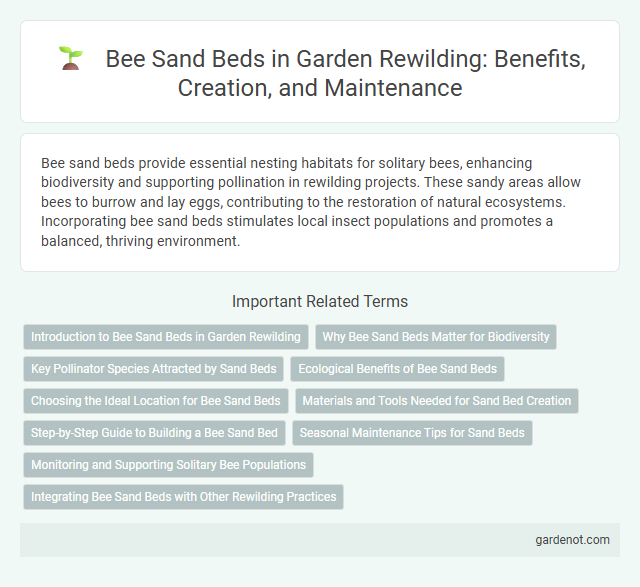Bee sand beds provide essential nesting habitats for solitary bees, enhancing biodiversity and supporting pollination in rewilding projects. These sandy areas allow bees to burrow and lay eggs, contributing to the restoration of natural ecosystems. Incorporating bee sand beds stimulates local insect populations and promotes a balanced, thriving environment.
Introduction to Bee Sand Beds in Garden Rewilding
Bee sand beds play a crucial role in garden rewilding by providing solitary bees, such as mining bees and plasterer bees, with essential nesting habitats. These beds consist of well-drained, sandy soil areas that mimic natural bee nesting sites, promoting biodiversity and supporting pollination services. Establishing bee sand beds enhances local ecosystems by sustaining native bee populations and improving plant health through efficient pollination.
Why Bee Sand Beds Matter for Biodiversity
Bee sand beds provide essential nesting habitats for solitary bees, which play a crucial role in pollination and maintaining ecosystem health. These beds support diverse bee species by offering well-drained, sandy soil ideal for burrowing and laying eggs, boosting local biodiversity. Protecting and creating bee sand beds helps sustain pollinator populations vital for plant reproduction and food webs.
Key Pollinator Species Attracted by Sand Beds
Bee sand beds provide essential nesting habitats for key pollinator species such as solitary mining bees (Andrena spp.) and leafcutter bees (Megachile spp.), which prefer sandy substrates for burrowing. These pollinators enhance ecosystem biodiversity by improving pollination rates for native plants and crops. Sand beds support the life cycles of these bees by offering safe, undisturbed spaces crucial for reproduction and population stability.
Ecological Benefits of Bee Sand Beds
Bee sand beds provide essential nesting habitats for solitary bees, enhancing pollinator diversity and supporting ecosystem resilience. These sandy environments facilitate natural bee reproduction cycles, increasing populations of native pollinators crucial for crop pollination and wild plant reproduction. By promoting healthy pollinator communities, bee sand beds contribute to improved biodiversity and sustain ecological balance in rewilded landscapes.
Choosing the Ideal Location for Bee Sand Beds
Selecting the ideal location for bee sand beds requires prioritizing sunny, sheltered spots with well-drained, sandy soil to support ground-nesting solitary bees like mining bees and sand bees. Positioning the bed facing south or southeast maximizes morning sunlight, which aids in warming the sand and stimulating bee activity. Proximity to diverse flowering plants within a 300-meter radius ensures ample foraging resources, enhancing the sustainability and effectiveness of the rewilding effort.
Materials and Tools Needed for Sand Bed Creation
Creating a bee sand bed requires selecting clean, well-draining sand mixed with fine gravel to replicate natural nesting habitats for solitary bees. Tools such as a shovel, rake, and level help shape and smooth the bed, while wooden boards or bricks can frame the area to maintain structure and prevent sand dispersion. Ensuring the sand remains dry and exposed to sunlight supports bee emergence and nesting success in rewilding habitats.
Step-by-Step Guide to Building a Bee Sand Bed
Create a bee sand bed by selecting a sunny, sheltered spot in your garden with well-drained, sandy soil. Dig a shallow depression around 15 cm deep and fill it with a mix of coarse sand and fine gravel to provide ideal nesting conditions for solitary bees. Maintain the bed by keeping the surface free of debris and ensuring it remains dry to encourage successful bee habitation and pollination activity.
Seasonal Maintenance Tips for Sand Beds
Sand beds for solitary bees require seasonal maintenance to ensure optimal nesting conditions and encourage pollinator populations. Clearing debris and scraping the surface in early spring prevents mold and parasite buildup while maintaining moisture balance supports larval development during summer. In late autumn, lightly raking and covering the beds with organic mulch protects the nests from harsh winter weather, promoting successful overwintering of native bees.
Monitoring and Supporting Solitary Bee Populations
Bee sand beds provide essential nesting habitats for solitary bee populations, crucial for biodiversity and pollination. Continuous monitoring through visual inspections and environmental sensors helps track population health and detect threats such as parasites or habitat degradation. Supporting these habitats involves maintaining clean, well-drained sand substrates and planting native flowering species to ensure adequate foraging resources year-round.
Integrating Bee Sand Beds with Other Rewilding Practices
Bee sand beds enhance biodiversity by providing solitary bees with essential nesting habitats, which complement pollinator-friendly wildflower meadows in rewilding projects. Integrating these beds with native plant restoration supports ecosystem resilience by improving pollination rates and encouraging natural pest control. Positioning bee sand beds near water sources and diverse floral resources maximizes habitat connectivity and species richness.
Bee sand bed Infographic

 gardenot.com
gardenot.com